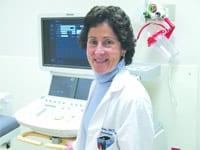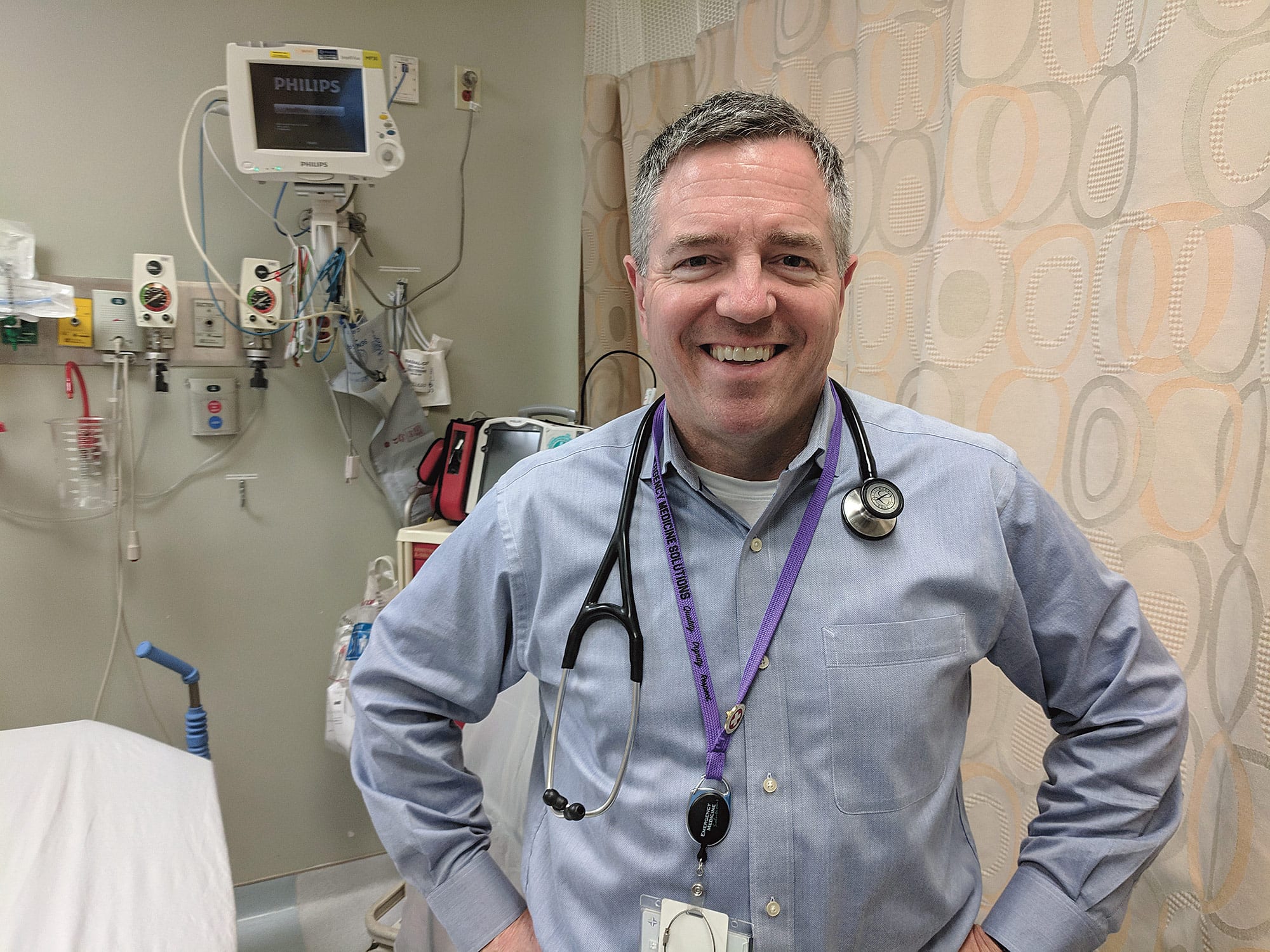Priming the Pump Baystate’s Heart Failure Program Gives Patients Tools to Live
Irene Moore’s primary care physician told her she was in bad shape, with only a few months to live, if that. But the Bernardston resident was determined not to let her congestive heart failure get the best of her.
“I’ve had just about everything done to me, from bypass surgery to adding a pacemaker,” Moore said. But then, a cardiologist who was treating her at Baystate Medical Center suggested she take part in the hospital’s Heart Failure Program.
“It has benefited me tremendously,” Moore said. “The program has helped me to improve my breathing, and I’m able to work more around the house, except for doing heavy cleaning, and I can get out more. I’m managing quite well now.”
Results such as these are not due to some revolutionary, high-tech treatment. Rather, the program simply works closely with patients and their families, crafting an individualized plan to manage heart failure more effectively — an effort that includes education, lifestyle changes, and referrals to the correct specialists when necessary, said Dr. Mara Slawsky, who directs the program.
“We talk about evidence-based therapy, what should be given to patients at different stages of the disease, and we make sure the patients are getting the optimal therapy,” she said.
In the process, Baystate is helping hundreds of Western Mass. residents understand that while heart failure often hastens the end of life, its effects can be slowed, and quality of life improved, by making the right choices every day.
“We work with patients, family members, visiting nurses and home care, rehabilitation centers, and referring doctors, but when the patient visits, it’s one-on-one,” Slawsky added. “We devote more time than they would have at the usual cardiology visit.”
Heart for Patients
According to the American Heart Association, some 5 million Americans live with some kind of heart failure, and 550,000 new cases are diagnosed each year.
That means there’s no shortage of sufferers in the Pioneer Valley. Currently, about 250 patients take part in Baystate program, which was launched more than three years ago, Slawsky said. Those cases encompass a wide range of conditions, from what is commonly called congestive heart failure — a weakening of the heart that makes it difficult to pump blood — to damage to the heart caused by an accident.
“Heart failure is any process that impairs the heart’s ability to provide good profusion of blood to the rest of the body,” she said. “That could mean either a weak heart or a heart abnormality.”
Because heart failure is a chronic condition, Slawsky said, the role of the Baystate program is different than one that seeks to heal or overcome a problem. “We want to help patients live longer, improve their quality of life, and make them more comfortable at the end of life,” she explained.
“That occurs through education, tailored management of their disease, and the involvement of the patient’s family and physician caregiver, whenever possible.
We’re trying to establish longevity and improve quality of life.”
Some patients are referred to the program by their primary-care physician, while others enroll following a hospital admission.
“If a patient comes in complaining of shortness of breath, he might get an imaging study, usually an echocardiogram,” Slawsky said. “If the patient has abnormalities of heart function, or we hear a murmur or demonstrate some other problem, they might be referred to the program.”
At first, patients are classified into one of four “stages” of heart failure: at risk but without heart disease; heart disease but not heart failure; heart disease with prior or current heart failure symptoms; and heart failure requiring specialized interventions.
Depending on the stage, Slawsky and her team may simply help a patient modify diet, lifestyle, and drug therapy, or they may refer him or her to more specialized care. In any case, the program is intended to be a more intensive, individual-centered model of care than the typical doctor visit.
“We absolutely feel that lifestyle is very important,” Slawsky said. “That includes lowering the amount of salt in the diet and maintaining a reasonable fluid intake. And cardiovascular fitness is key, so we try to get patients into a rehab program or a daily exercise regimen. We really stress the importance of a healthy lifestyle.”
Moore, for one, credits the program’s educational component, which has convinced her to weigh herself daily to watch her water weight, as well as keeping careful track of her water and salt intake.
“I learned it was very important to change my diet and eat less red meat,” she said. “I now eat very little red meat and more chicken and turkey, and lots of fresh vegetables and fruits. And I have light yogurt every morning, too.”
“We focus on prevention first,” Slawsky said. “We want to modify people’s risk factors for heart disease.”
Not-so-golden Years
Although heart failure can strike any age group, it’s relatively uncommon under age 50, and is primarily a condition of the elderly, Slawsky noted. In fact, about 10{06cf2b9696b159f874511d23dbc893eb1ac83014175ed30550cfff22781411e5} of people age 75 or older suffer from it, with women’s cases slightly surpassing men among that age bracket. Meanwhile, Medicare spends more money for the diagnosis and treatment of heart failure than any other condition.
That means any heart failure program must be sensitive to the specific issues of the elderly, Slawsky said. “Because this is a progressive disease, we also address end-of-life issues for patients,” such as hospice care, she explained. “We recognize that this is not a static process, but a continual one.”
Also continual is Baystate’s efforts to become involved in device therapy. As ventricular-assist devices — pumps that assist the heart’s work — become more effective and common, Slawsky said the hospital would like to branch into this field.
“We’re already trying to identify patients for the most advanced therapies and assist devices and transfer them to centers where those modalities are available,” she said. “But at some point in the future, we’d like to offer that to our patients. We’d like to establish ourselves as a referral center for device therapy.”
Meanwhile, the program chugs on, helping patients cope with heart failure and tracking their progress.
“We’ve created a database from which we pull outcomes: things like rehospitalizations and medication adherence,” Slawsky said. She said patients also complete quality-of-life surveys to track results and help Baystate further hone its program, but she recognized that return admissions to the hospital are the key indicator of how well they’re doing.
“From that perspective, they’re doing better with this disease management program,” she said. After all, scheduled hospital visits sure beat the emergency kind.


